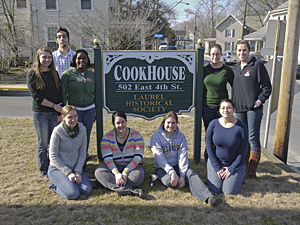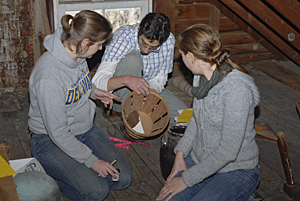

ADVERTISEMENT
- Rozovsky wins prestigious NSF Early Career Award
- UD students meet alumni, experience 'closing bell' at NYSE
- Newark Police seek assistance in identifying suspects in robbery
- Rivlin says bipartisan budget action, stronger budget rules key to reversing debt
- Stink bugs shouldn't pose problem until late summer
- Gao to honor Placido Domingo in Washington performance
- Adopt-A-Highway project keeps Lewes road clean
- WVUD's Radiothon fundraiser runs April 1-10
- W.D. Snodgrass Symposium to honor Pulitzer winner
- New guide helps cancer patients manage symptoms
- UD in the News, March 25, 2011
- For the Record, March 25, 2011
- Public opinion expert discusses world views of U.S. in Global Agenda series
- Congressional delegation, dean laud Center for Community Research and Service program
- Center for Political Communication sets symposium on politics, entertainment
- Students work to raise funds, awareness of domestic violence
- Equestrian team wins regional championship in Western riding
- Markell, Harker stress importance of agriculture to Delaware's economy
- Carol A. Ammon MBA Case Competition winners announced
- Prof presents blood-clotting studies at Gordon Research Conference
- Sexual Assault Awareness Month events, programs announced
- Stay connected with Sea Grant, CEOE e-newsletter
- A message to UD regarding the tragedy in Japan
- More News >>
- March 31-May 14: REP stages Neil Simon's 'The Good Doctor'
- April 2: Newark plans annual 'wine and dine'
- April 5: Expert perspective on U.S. health care
- April 5: Comedian Ace Guillen to visit Scrounge
- April 6, May 4: School of Nursing sponsors research lecture series
- April 6-May 4: Confucius Institute presents Chinese Film Series on Wednesdays
- April 6: IPCC's Pachauri to discuss sustainable development in DENIN Dialogue Series
- April 7: 'WVUDstock' radiothon concert announced
- April 8: English Language Institute presents 'Arts in Translation'
- April 9: Green and Healthy Living Expo planned at The Bob
- April 9: Center for Political Communication to host Onion editor
- April 10: Alumni Easter Egg-stravaganza planned
- April 11: CDS session to focus on visual assistive technologies
- April 12: T.J. Stiles to speak at UDLA annual dinner
- April 15, 16: Annual UD push lawnmower tune-up scheduled
- April 15, 16: Master Players series presents iMusic 4, China Magpie
- April 15, 16: Delaware Symphony, UD chorus to perform Mahler work
- April 18: Former NFL Coach Bill Cowher featured in UD Speaks
- April 21-24: Sesame Street Live brings Elmo and friends to The Bob
- April 30: Save the date for Ag Day 2011 at UD
- April 30: Symposium to consider 'Frontiers at the Chemistry-Biology Interface'
- April 30-May 1: Relay for Life set at Delaware Field House
- May 4: Delaware Membrane Protein Symposium announced
- May 5: Northwestern University's Leon Keer to deliver Kerr lecture
- May 7: Women's volleyball team to host second annual Spring Fling
- Through May 3: SPPA announces speakers for 10th annual lecture series
- Through May 4: Global Agenda sees U.S. through others' eyes; World Bank president to speak
- Through May 4: 'Research on Race, Ethnicity, Culture' topic of series
- Through May 9: Black American Studies announces lecture series
- Through May 11: 'Challenges in Jewish Culture' lecture series announced
- Through May 11: Area Studies research featured in speaker series
- Through June 5: 'Andy Warhol: Behind the Camera' on view in Old College Gallery
- Through July 15: 'Bodyscapes' on view at Mechanical Hall Gallery
- More What's Happening >>
- UD calendar >>
- Middle States evaluation team on campus April 5
- Phipps named HR Liaison of the Quarter
- Senior wins iPad for participating in assessment study
- April 19: Procurement Services schedules information sessions
- UD Bookstore announces spring break hours
- HealthyU Wellness Program encourages employees to 'Step into Spring'
- April 8-29: Faculty roundtable series considers student engagement
- GRE is changing; learn more at April 15 info session
- April 30: UD Evening with Blue Rocks set for employees
- Morris Library to be open 24/7 during final exams
- More Campus FYI >>
9:01 a.m., Jan. 28, 2011----Last year, Norma Jean Fowler, then president of the Laurel Historical Society, inventoried 259 items in the society's collection, labeling each and recording its description and the history of how it came to the society -- a process museum professionals call accessioning.
This year, during eight days in January, a group of graduate students from the University of Delaware's Museum Studies program accessioned more than 400 items in the same collection. Working under a grant from the Institute of Museum and Library Services awarded to the Delaware Division of Libraries, ten students, a professor and an independent consultant not only gave the small historical society a big head start on better organizing and preserving its collections, but they also set the stage for similar efforts at other such organizations.
In Laurel, the goal is to create a complete electronic inventory of the collection, so that researchers and the community can use that database to find what they need.
“We've been trying to improve our record-keeping, and we were making progress slowly but surely, but these students have given us a real jump start, and we couldn't be more grateful for the help,” Fowler said on the final day of the project. “They've given us a great foundation to build on, and they've even found things that we didn't know we had. This will enable us to capture and document the stories behind the objects.”
Established 30 years ago, the historical society didn't have a home for the first 20 of those years, instead moving its collection from one storage space to another. Now located in the historic Cook House on Market Street in the town's historic district, it relies on dedicated volunteers and is open to the public only on a limited basis in the summer months, although Fowler said she'd love to see expanded hours in the future.
Collections extensive, varied
The society's collections are extensive and varied, from hand-made flapper-era dresses to old balance sheets from the town's bank to peach baskets used by the local fruit-packing plant. All the objects reflect the history of a town that was once the third-largest municipality in the state and today boasts 800 homes on the National Historic Register.
“We found that the collection gave a real sense of what life was like in Laurel in the past,” said Katherine C. Grier, professor of history and director of the Museum Studies program, who oversaw the students' work. “The thing that was so great about this inventory demonstration project is that it was a 'blitz.' We called ourselves the 'Inventory SWAT team' because of how much we did in just eight days.”
The students, all pursuing master's or doctoral degrees in history, performed a variety of tasks. Those included sorting the items in the museum's clothing collection, making cloth labels for the pieces that were able to be preserved and hand-sewing the labels onto an unobtrusive spot on each garment.
“We worked with more than 100 pieces of clothing and accessories that we determined could be displayed,” student Retz Monroe said. “Most were from the late 1800s or early 1900s, and all of them were local -- either homemade by Laurel residents or sold in Laurel stores. There were party dresses, a two-piece men's bathing suit, lots of hats ... just so much variety.”
Members of the “SWAT team” who worked with old records from what was formerly the People's National Bank of Laurel found mold on many of the books. They donned respirators and used a special vacuum cleaner outfitted with cheesecloth to remove the dried mold.
“I've never done a museum internship before, so I didn't know what to expect, but I probably never would have expected to be vacuuming mold,” student Kevin Impellizeri said. “But it was a great experience. It's good to really understand the nuts and bolts of the process.”
Grier said the jobs were organized to give each student as much variety as possible. “It can be difficult to for students to get hands-on experiences in collections, and this project is providing a lot of them!” she wrote on the blog for the project. “There is no substitute for handling collections and for making decisions in a setting where the constraints are real: limited time, funds and space.”
Systematic records lacking
The grant that funded the project came about after a national study found that 80 percent of small museums lack systematic records of their collections, which are in danger of falling into disrepair. The Laurel project, which will enable the historical society to enter its inventory into a database called PastPerfect, can serve as a demonstration of one way in which other small organizations could begin to better organize and preserve their holdings, Grier said.
During spring semester, another group of museum studies students, working under the same grant, will help organize the archives at Auburn Heights Preserve, a new state park in Yorklyn, Del.
Article by Ann Manser
Photos by John F. Manser


